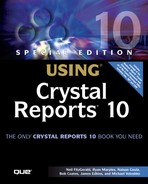Introducing Ad-Hoc Reporting Conceptually
Too many competing definitions of ad-hoc reporting exist to dispense with any introduction. This chapter does not pretend to address the larger question of defining ad-hoc as a concept, but rather seeks to place the Crystal Enterprise Ad-Hoc tool into context. Simply put, Ad-Hoc reporting or queries are impromptu questions you put to the data to extract answers. Although many permutations exist, from systems that enable the end user to directly query source data in raw form to accessing OLAP cubes, from tools for very SQL-savvy users to point-and-click tools, from preformatted or unformatted query tools to tools that enable pixel-level formatting, many tools and definitions exist in the marketplace.
Crystal Enterprise's Ad-Hoc tool most facilitates end-user Crystal Reports development and modification through a Web browser. Whether the data source is a database, prebuilt Business View, or another Crystal Report, the result is always a Crystal Report. Although Crystal Analysis provides end users great interactivity, its exclusive connectivity to an OLAP data source helps you categorize it as an Analytic rather than Ad-Hoc tool.
Most organizations debate the amount and type of deployment of various types of Business Intelligence, from reporting to ad-hoc reporting, to query and analysis, to analytic workbooks, to purpose-built applications. Briefly, a typical organization, after reaching a mature stage of Business Intelligence deployment, finds that roughly 80%–90% of information distribution takes place with preformatted reports. Roughly 10%–15% might be ad-hoc queries and another 5% analytics. Every organization varies, but a balance between the time and training necessary for end users to interact with data and the value they derive in the process should be fundamental.
Many organizations actually adopt ad-hoc reporting as a method to reduce IT workload/spending and to provide increased end-user access to data. The Ad-Hoc tool facilitates this approach by enabling end users to develop a Crystal Report themselves. This Crystal Report can then be saved into the Crystal Enterprise system and viewed at any time, or even passed to IT for special features to be added. This concept that end users can do more themselves provides significant cost-savings, but recognition that IT will always play a role in Business Intelligence marks a mature approach to the problem at large.
The remainder of this chapter focuses on how to use the Ad-Hoc application as well as the Excel add-ins for Crystal Reports and Crystal Analysis.
